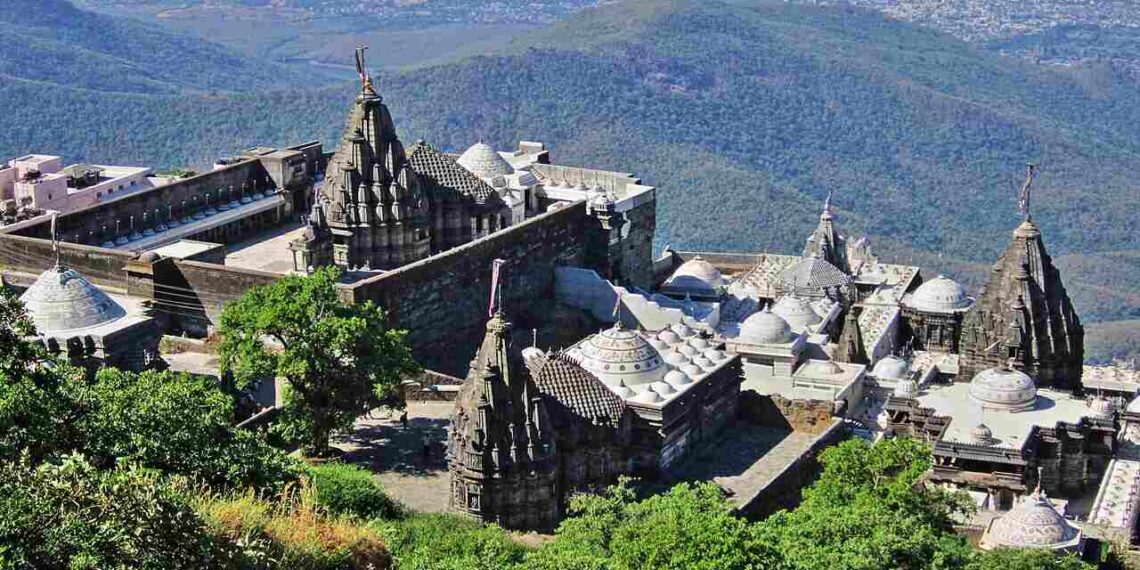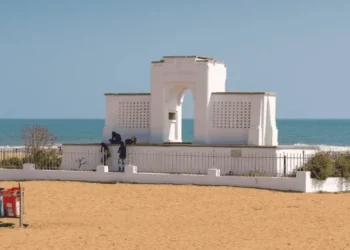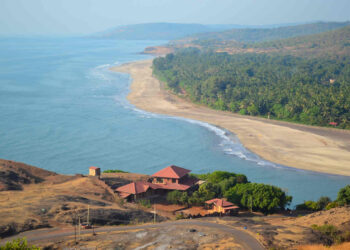Set high on Girnar Hill in Junagadh, Gujarat, the Girnar Jain Temples are a holy cluster of shrines for Jain Tirthankaras, mainly Lord Neminath, the 22nd Tirthankara. Built over many years, starting long ago in the 12th century, by Jain Sanghs, these temples, belong to the Śvetāmbara sect, some also belong to the Digambara sect.
Fun Fact: The Neminath Temple’s idol is said to have a faint blue glow at sunrise.
Mythological Importance
Girnar Jain Temples hold deep Jain tales. One story says Lord Neminath, also called Arishtanemi, the 22nd Tirthankara, became an ascetic after he saw that animals tied up to be slaughtered for the feast on his wedding were crying and screaming to be released. Seeing this he realised that due to his wedding thousands of animals were to be killed. He renounced all worldly pleasures and went to Mount Girnar to attain salvation. He attained omniscience and Moksha (Nirvana) from the highest peak of Mount Girnar. His bride-to-be Rajulmati also renounced the world and became a nun, and followed him to the sacred mountain. Another tale tells of a trader praying here for a safe journey, and his wish came true after vowing a shrine. People here think climbing Girnar with prayers cleans sins and brings calm. As a big Jain pilgrimage, it’s tied to non-violence and pure living taught by Tirthankaras.
Historical Overview
The temples began round the 12th century under Chaulukya kings, but worship likely started earlier. Junagadh was a Jain hub, with rich traders funding shrines. A stone from 1128 shows early work. Raiders hurt it in the 14th century, but Jain Sanghs built it back. By the 1700s, more temples were added. After 1947, the Anandji Kalyanji Trust took over. Fixes in the 1970s kept the old look. Jain monks way back spread its name in talks. Now, many climb Girnar’s holy slopes. In fact, ruins near Girnar show a Jain town from long ago.
Architecture of Girnar Jain Temples
Girnar Jain Temples cover Girnar Hill, built in Jain style. There are many temples built in seperate period of time like Temple of Neminath, which is the largest and oldest temple, dedicated to the 22nd Tirthankara, Triple Temple of Mallinath: dedicated to the ninth Tirthankara, Rishabhdev Temple: situated nearby, in golden color, Parshwanath Temple (Meravasi): built in the 15th century, Ambika Temple. The main Neminath Temple, from the 12th century, has a tall spire with carvings of Neminath sitting, lotus blooms, and Jain signs, all in white marble. It is west-facing and built from black-grey granite. The central temple has three components; mulaprasada (central shrine) and two halls: gudhamandapa (principal hall) and second mandapa (outer hall). Inside, there’s a 3-foot marble statue of Neminath, legs crossed, deep in thought, lit by soft lamps. The inner walls have marble slabs with Jain prayers.
The temples have halls with pillars carved with elephants and gods. Small shrines for Parshvanath, Adinath, and Mahavir are on the hill, made of marble. The Parshvanath one shows him with a snake hood, for safety. The Adinath one, from 1400, has him standing, for purity. The Mahavir one shows him teaching, for truth. The grounds, with stone paths, feel holy, high on the hill. A water tank for rituals has plain steps. Pillars tell Tirthankara stories, guiding those who come. The hill’s view brings quiet.
Rituals and Festivals
The temples stir when festivals come. Paryushan, in August or September, is the biggest one, with fasting and praying by devotees for eight days. Mahavir Jayanti, in April, marks Mahavir’s birth with a climb. Diwali, in October or November, honors Mahavir’s final peace with lamps. Kartik Purnima, in November, brings thousands to climb. Samvatsari, in Paryushan, is for saying sorry.
Information for Travelers
Hours and Entry: Open every day, 6:00 AM to 8:00 PM. It’s free to go in, but prayers cost ₹100-300. No pictures in inner rooms.
Clothing: Wear clothes that cover shoulders and knees. Women for prayers wear sarees or suits, men wear kurtas.
How to Get There:
Air: Rajkot Airport, 100 km away, is closest.
Train: Junagadh Station, 5 km away, links to Ahmedabad (7 hours).
Road: Buses from Rajkot (2 hours) come to Junagadh.
Best Time to Visit: October to March is cool, 20-30°C. Weekdays are quiet. Kartik Purnima’s busy, so plan early.
Nearby Attractions:
Uparkot Fort, 5 km away, is an old fort.
Girnar Ropeway, 1 km away, helps reach the temples.
Gir National Park, 50 km away, has lions.
Mahabat Maqbara, 6 km away, is a grand tomb.
Ashokan Edicts, 7 km away, are ancient rock writings.
Final Thoughts
Girnar Jain Temples in Junagadh, Gujarat, a holy spot in western India, is a treasure for the heart. The Tirthankaras’ pure touch reaches all who climb, making it a place you must see among India’s sacred spots.











